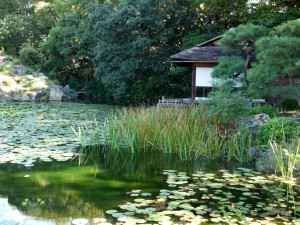As I mentioned yesterday, I took a quick walk up to a nearby temple to verify its location. Today, I woke up early and decided to head right up.
For breakfast, I didn’t want to waste time, so I crossed the street to Kyoto Station and popped into the 7–11. I polished off an energy bar and a bottle of milk, then headed north.
I soon arrived at Nishi-Honganji. It’s hard to get across just how huge it is. According to the placard outside, it’s one of the largest wooden structures in the world. It’s simply tough to build anything this big out of wood. But there it stands, housing a beautiful inner shrine full of gold.
I left to find this temple’s brother. I found the appropriate location, but something was wrong. All I could find was two big warehouses surrounded by a large traditional stone wall.
I explored the wall’s perimeter, turned the ocrner, and found the temple entrance. Those weren’t warehouses. I had found the temple Higashi-Honganji, which is the biggest wooden structure in the world. It was under restoration, so the workers had built a larger building around it.
Fortunately, the adjoining temple was still open to the public, though one had to take off one’s shoes before climbing the giant wooden stairs. This included a new trick: plastic bags were provided, into which you put your shoes, then you carried them around with you, so you couldn’t accidentally put on somebody else’s shoes when you left.
And now I faced the most difficult challenge of the day. My stomach was growing increasingly upset, and I headed to the nearest bathroom. A dozen pairs of public slippers sat at the entrance to the bathroom, which was nice, so I went in and found a (blessedly Western-style) toilet. I sat, and nothing happened. But my stomach grew increasingly upset.
A few minutes later, I stood, turned around, and began throwing up.
I’ve no idea what caused it. I have a sensitive stomach anyway, and as usual, I threw up just a little saliva and bile. Thankfully, nobody else was in the bathroom to hear. I was mortified, but at least it ended quickly.
I headed back outside and sat down on the temple steps for about half an hour. The weather had turned warm but breezy, so I simply luxuriated in the breeze as my stomach settled.
I was determined to enjoy the rest of the day anyway. Maps are posted strategically around the streets of Kyoto, and I saw a few more places to try.
First, Kyoto Aquarium. On the one hand, it was…an aquarium. Fish in tanks. On the other hand, it had lots of weird sea creatures, and the staff happened to be feeding all the animals when I visited. I watched sea lions and dolphins swim and jump for nearly half an hour.
As I mentioned during my Mexican cruise report: a dog looks at you and asks, “What’s next, boss?” A dolphin looks at you and asks, “What’ve you got, human?” They’re friendly, but they treat you as an equal to be indulged.
I then headed east. Just wandered the city. I saw another traditional wall, went in, and discovered my favorite find in Kyoto: Shousei-en Garden. It’s a samurai mansion and garden, the mansion still maintained but closed to the public, with the garden open for anyone to walk through (with a suggested donation).
Shouse-ein is the classic Japanese garden experience: koi pond, stone bridges, tea house; you name it. Perfectly maintained and easy to explore (though the covered bridge is designed for the Japanese of a hundred years ago, so you’ll have to duck).
Satisfied, I returned to 7–11 for a packaged dinner and bed, figuring I’d wind down.
I switched on the TV and flicked over to the weather. I’d be leaving Japan in a few days, so I wanted to see what to expect. That’s when I saw news of the typhoon scheduled to wrap around Japan for the next few days.
Some rather frantic web surfing later, I discovered an odd fact. Japan’s affect by many typhoons, but few of them do much other than batter a few cities on the extreme coasts. Indeed, the forecast called for only 20%-50% chance of rain in Tokyo for the next few days. The typhoon would brush the west edge of Japan’s main island of Honshu, then head north-east as it calmed into a tropical storm.

